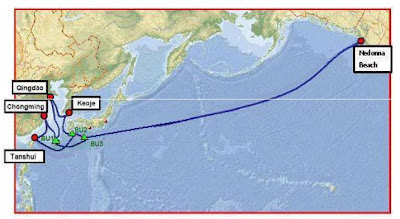This will highlight and shall actually be a summary of the talk given by Bill Barney / Pacnet several times ago.
Several facts happened in Asia:
- 41% of the world’s fixed line users
- More than 40% of the world’s mobile users : Number of subscribers in Asia has grown from 280m to more than 950m between 2003-2007 (GSMA, ITU, Frost & Sullivan); More than 210 million users have signed up for 3G services in Asia since the launch of the first high-speed mobile network data network in Korea in 2000 (CDMA Development Group)
- 38.7% of the world’s Internet subscribers: Growth (2000-2007) at 346.6%, compared to the rest of the world at 228.1%
- Over 42% of the world’s broadband Internet users: The number of broadband connections in Asia nearly quadrupled between 2003-2007 (27.3m to 100.5m); 128m out of world’s 350m broadband subscribers are in Asia. (Buddecom)
Those things are enforced among other by the following key drivers:
Driver#1: Asian traffic becoming more intra-asia as countries become a tighter market and content moves from the US to Asia; Data Traffic Pattern in the Region Becoming More Intra-Asia Oriented (Source: Gartner & Pacnet Estimates):
- Over 60% of traffic from Asia is intra-Asia
- The percentage of total traffic from many Asian countries to the U.S. is declining
- Local network capacity in Asia has become more pervasive and cost-competitive
- Regulatory changes have improved local termination costs
- Asian content creation and storage was rapidly migrating to Asia
Driver#2: supply and demand have started to become aligned; the matching of supply & demand has created a leveling of bandwidth pricing
Driver#3: Glass and content owners have an advantage over renters; traditional carriers in the services market who are wedded to leased capacity, rented last miles and paid IP transit are at a huge cost disadvantage
Driver#4: Asia has Fortune 500 companies driving 20%-30% of business, THE REST is through smaller corporate customers…
Driver#5: Customers are requiring more complex services and higher levels of management/support
Remarks- The market is too broad and growing too fast for anyone to dominate;
- Different cost advantages at the local, international and content delivery level will create competition across assets classes;
- Collaboration is and will be inevitable alongside competition
- 14 new cables and extensions underway (USD 7.1 bn, see below): One built by sole owner (TGN Pacific??), Nine have at least three partners, Four have more than 10;
- Nobody has invested more than $180M of their own capital on a project; From 1998 to 2001, 14 cable investments of over $1b were made by standalone companies
- Diversification of investment is the theme
- 180 Fortune 500 Customers on Pacnet: 80% of the revenue delivered is on the network, 20% of the revenue is delivered on partners; Average deal requires six to 12 partners!
- One Customer: Austrade and DFAT --> 94 network providers collaborating, 31 countries touched, 22 major partners
- The Age of the “Global Carrier” is Over; The Age of the Standalone cable company is Over
- Collaboration and Cooperation are here for the years to come… your competitor today will be your partner or co-investor tomorrow
- Be friends ! :-D


 Some Statistics Taken from Pacnet/Bill Barney (Courtesy of Each Marked Company)
Some Statistics Taken from Pacnet/Bill Barney (Courtesy of Each Marked Company)

















































